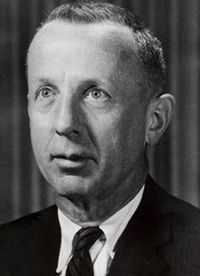Charles P. Kindleberger

Charles Poor "Charlie" Kindleberger (October 12, 1910 – July 7, 2003) was a historical economist and author of over 30 books. His 1978 book Manias, Panics, and Crashes, about speculative stock market bubbles, was reprinted in 2000 after the dot-com bubble. He is well known for hegemonic stability theory. He has been referred to as "the master of the genre" on financial crisis by The Economist.[1]
Life
Kindleberger was born in New York City on October 12, 1910. He graduated from the Kent School in 1928, the University of Pennsylvania in 1932, and received a PhD from Columbia University in 1937. He later held the position of Ford International Professor of Economics at the Massachusetts Institute of Technology.
He died on July 7, 2003 in Cambridge, Massachusetts. He was married to the Sarah Miles Kindleberger for 59 years, and the couple had four children: Charles P. Kindleberger III, Richard S. Kindleberger, a reporter for the Boston Globe, Sarah Kindleberger and E. Randall Kindleberger.[2][3]
Work
Kindleberger's earliest book was International Short-Term Capital Movements (1937).
Although mainly an academic at MIT after 1948, during the course of his life Kindleberger worked for several American institutions, such as the Federal Reserve Bank of New York (1936–1939), the Bank of International Settlements in Switzerland (1939–1940), and the Board of Governors of the Federal Reserve System (1940–1942). He was a leading architect of the Marshall Plan.[2] In 1945–1947 he served at the Department of State as Acting Director of the Office of Economic Security Policy, and briefly from 1947-48 as counselor for the European Recovery Program.
Kindleberger described his around-the-clock work to develop and launch the Marshall Plan with singular passion in a 1973 interview.
"We were conscious of a great sense of excitement about the plan. Marshall himself was a great, great man—funny, odd but great—Olympian in his moral quality. We'd stay up all night, night after night. The first work ever done that I know about in economics on computers used the Pentagon's computers at night for the Marshall Plan. I had a tremendous sense of gratification from working so hard on it."
As an "historical" economist, or economic historian, Kindleberger relied on narrative exposition and knowledge of history rather than mathematical models to prove his point. His book, Manias, Panics, and Crashes is still required reading at many Masters of Business Administration (MBA) programs in the United States.
The World in Depression
His 1973 and 1986 book The World in Depression 1929–1939 (University of California Press, 1986 [Revised and Enlarged Edition]) advances an idiosyncratic, internationalist view of the causes and nature of the Great Depression. Blaming the peculiar length and depth of the Depression on the hesitancy of the US in taking over leadership of the world economy when Britain was no longer up to the role after World War I, he concludes that "for the world economy to be stabilized, there has to be a stabilizer—one stabilizer", by which, in the context of the interwar years at least, he means the United States. In the last chapter "An Explanation of the 1929 Depression". Kindleberger lists the five responsibilities the US would have had to assume in order to stabilize the world economy:
- maintaining a relatively open market for distress goods;
- providing countercyclical, or at least stable, long-term lending;
- policing a relatively stable system of exchange rates;
- ensuring the coordination of macroeconomic policies;
- acting as a lender of last resort by discounting or otherwise providing liquidity in a financial crisis.
Kindleberger was highly skeptical of Milton Friedman and Anna Schwartz's monetarist view of the causes of the Depression, seeing it as too narrow and perhaps dogmatic, and dismisses out of hand what he characterized as Paul Samuelson's "accidental" or "fortuitous" interpretation. The World in Depression was praised by John Kenneth Galbraith as 'the best book on the subject'.
Works
- International Short-term Capital Movements (NY: Columbia University Press, 1937)
- Economic Development (New York, 1958)
- International Economics (Irwin, 1958)
- Foreign Trade and the National Economy (Yale, 1962)
- Europa and the Dollar (Cambridge, Massachusetts, London, 1966)
- Europe's Postwar Growth. The Role of Labor Supply (Cambridge, Massachusetts, 1967)
- American Business Abroad (New Haven, London, 1969)
- "The Benefits of International Money." Journal of International Economics 2 (Nov. 1972): 425–442.
- The World in Depression: 1929–1939 (University of California Press, 1973)
- Manias, Panics, and Crashes: A History of Financial Crises (Macmillan, 1978)
- World Economic Primacy: 1500 – 1990 (Oxford University Press, 1996)
- Economic Laws and Economic History (Cambridge University Press, 1997)
References
Notes
- ↑ "A dance to the music of debt" The Economist (November 3, 2012)
- ↑ 2.0 2.1 Obituary, The Tech (July 9, 2003)
- ↑ Opinion Economist.com (July 17, 2003)
Further reading
- Peter Temin (2008). "Kindleberger, Charles P. (1910–2003)." The New Palgrave Dictionary of Economics, 2nd ed. Abstract.
External links
- MIT's obituary
- Historical Economics – Art or Science? (1990) by Charles P. Kindleberger (online book)